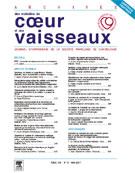06-59 - LOWER LEVELS OF FETUIN A IS ASSOCIATED WITH VALVULAR CALCIFICATION AND STENOSIS PROGRESSION IN THE ELDERLY PATIENTS WITH AORTIC STENOSIS - 09/04/08
Dania MOHTY [1],
D Mohty [2],
P Pibarot [2],
JP Després [2],
A Cartier [2],
B Arsenault [2],
P Mathieu [2]
Voir les affiliationsIntroduction: Aortic stenosis (AS) is a disease process involving an active calcification of the aortic valve. Its prevalence increases markedly with aging. There remain uncertainties as to whether mechanisms leading the development and progression of AS in elderly subjects are similar to those in the younger population. We hypothesized that the blood level of fetuin A, an important circulating protein with anti-calcifying properties, would be involved in pathophysiology of AS in the elderly population.
Methods: In 114 patients operated for AS, the plasma level of fetuin A as well as complete blood lipid profile including the size of LDL particles were determined. Calcium content of the aortic valve was measured. In a subset of patients (n = 55) for whom at least two transthoracic echocardiography (TTE) separated by at least 6 months were available pre-operatively, the annualized hemodynamic progression rate of the stenosis was calculated.
Results: In the elderly patients (divided in age quartile) the low-density lipoprotein cholesterol (LDL-C) (p = 0.03), triglyceride (p = 0.01), LDL-C content in small size LDL particles (LDL-C < 255Å) (p = 0.007), apoB/ApoA-I ratio (p = 0.01), and fetuin A (p = 0.004), were all significantly lower compared to younger patients. In the highest age quartile group (>=77 years), lower level of fetuin A was associated with increased valvular calcium content (p = 0.03) and with faster hemodynamic progression rate as measured by the annualized maximum aortic transvalvular gradient (p = 0.04). In this quartile, low fetuin A level remained significantly associated with valvular calcium (p = 0.02) and preoperative progression rate of gradient (p = 0.02) after adjustment for covariables. In the whole cohort of patients, fetuin A levels was negatively correlated with age (r =-0.34; p = 0.0002) and CRP (r =-0.19; p = 0.05), whereas it was positively correlated with triglyceride levels (r = 0.21; p = 0.02). On multivariate analysis, age was the only variable associated with decreasing concentration of circulating fetuin A.
Conclusion: The elderly patients had a less atherogenic lipid profile. However, this positive effect may be counterbalanced by the age-related reduction in fetuin A, which in turn may contribute to enhanced valvular calcification and disease progression in the elderly.
Plan
© 2007 Elsevier Masson SAS. Tous droits réservés.
Vol 100 - N° 12
P. 1087-1088 - décembre 2007 Retour au numéroBienvenue sur EM-consulte, la référence des professionnels de santé.

